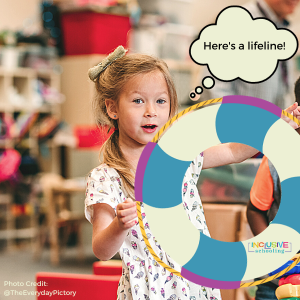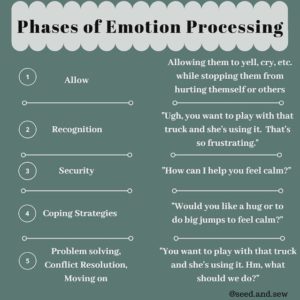Despite the common practice of not giving attention to a student that is upset in some way, it is at that very moment that the child NEEDS our attention the most.
- Maybe you were told to ignore it because others have told you to ignore “attention seeking behaviors”
- Maybe you were following a behavior plan that was developed after weeks of analyzing the function of the child’s behavior (spoiler alert…it’s not just attention seeking or avoidance)
- Or maybe you were super worried about reinforcing “bad behaviors” that could get stronger and stronger
We get it. We do.
Many of our current beliefs and practices haven’t caught up with what we know about early brain development, how self-regulation develops in humans, and the impact of stressors and trauma on how the body responds.
So, instead of ignoring the child…what should we do?
If you are seeking a more compassionate and effective approach to responding to behaviors that are challenging, keep reading.
What To Do?
Before we get into strategies, we have to talk about our mindset.
It’s always mindset before methods.
Think of it this way…let’s say you are the captain of a boat, and the child who is upset (the one who is “seeking your attention”) has fallen overboard.
What would you do?
- Would you make a mental note of what caused the passenger to fall over (e.g., determine the antecedents or triggers that preceded the incident)?
- Would you remind the passenger (the one who is actively trying not to drown) that they aren't following the rules right now?
- Would you walk away and wait for the passenger to figure out how to get back on the boat on their own?
When it comes to helping your drowning passenger, we hope you would choose offering a lifeline.
But it’s not that easy.
Here’s where the shark music begins…or as Brene Brown would say, “Here's the story you start telling yourself.” It goes a little something like this…
- How in the world can I continue to steer the boat and rescue the passenger?
- What if I rescue them, will they think it is ok and swim anytime they want?
- Should I use this as a teachable moment and remind them that boat rules specifically require the use of “walking feet” while on deck? For goodness sake…the rules are clearly posted all over the boat.
- What will the other passengers think? Maybe they’ll all decide that it looks like a good day to swim, and will jump into the water.
It gets complicated fast, right?!?!
Yet, if you can turn down the shark music you’ll see that you can, with some grace and ease:
- Put the boat in idle- there really isn’t a rush to get somewhere
- Try not to worry about what the drowning passenger will learn because they are in the red or blue zone at this point and just need rescued
- The boat’s manual of rules likely needs updated…plus restating rules as they are being broken rarely results in higher rates of people following the rules
- The other passengers will come to understand that you are there to help when they are in need, that perhaps there is something they can to do help, or more than likely, they haven’t even noticed that a fellow passenger has fallen overboard
Long story short, when it comes to behaviors that can be challenging, our job is to recognize that the child is outside the zone of optimal learning (aka outside the “green zone“), and that they need us to help them “get back on board”.
List of Possible Lifelines
Here is a list of things you can do to offer a “lifeline” when a child is overboard. In other words, when their systems are hyperaroused (e.g., they are in the red zone and acting angry, being rigid, and are overwhelmed) or hypoaroused (e.g., they are in the blue zone and acting confused, feeling disconnected, and are shut down).
- Validate emotions
- Offer choices (especially ones based upon interests and that are coping strategies, calming, and/or restorative)
- Go silent (some say offer supportive silence or approach silently because it is very different than ignoring)
- Reduce directions and corrections
- Ask open-ended questions aimed to understand instead of teach
- Use soothing tone of voice and empathetic non-verbals
- Reduce interruptions – pause – try not to rush
- Simplify language – slow down all movements
- Practice sound minimalism (say very little, turn off TVs/radios, talk in low tones)
- Reduce visual clutter
- Read cues – touch – be close – be attuned
But Why Lifelines?
The goal (when we find ourselves or others, particularly children, have fallen overboard) is to soothe the limbic system, to create calm in the mind and body so the system registers that it is safe.
- Goal is to connect – not to force compliance (Barb Avila)
- Goal is to process – not to rush big emotions (Alyssa Blask-Campbell)
- Goal is to focus on development – not management (Laura Fish)
When we feel safe, when our needs for satisfaction and connection are met, then we are able to activate our “thinking brain”…where we can remember the rules, make good choices, take the perspective of others, and think before we act.
Lifelines, while powerful, aren't magical.
We're human…we're always going to find ourselves in the red or the blue zone at times. But with a lifeline, we are able to “get back on board” with a bit more grace and ease.
Lifelines also help reduce the intensity, frequency, and even the duration of time spent in the red or blue zone.
Which Lifeline Is Best?
The fact is, for each situation, each child…you may have to toss out different lifelines.
Here are a few ideas to help you get started:
- Start with strong attuned relationships – The better you know the child, the calmer you remain, and the more focused you are on connecting, the easier it is to figure out which lifeline to throw.
- Use data to inform – It is totally fine to do something formal like a Functional Behavior Assessment (FBA), but it's also acceptable to pay attention to what is happening in the moment and keep note of it. If you offer the lifeline of ‘touch' or say something like, “You seem mad that it's time to clean up”…and the child hits or screams, you know the lifeline wasn't a match for that moment.
- Good old fashion trial and error – Make sure you have tons of lifelines ready and then give them a try. It may take time to figure out which ones feel good to you, which ones help soothe children's limbic systems, and which ones are doable for your setting.
Additional Ways To “Get Them On Board”
(aka other ways to offer lifelines)
- Barb Avila – Synergy Autism Center's “Weathering the Storm” (tip sheet)
- Dr. Stuart Shanker's “It's Smartest to Co-Regulate” (download)
- Here's a FB live Kristie did on how to offer lifelines for a child who started running instead of helping to clean-up and transition to a group activity. You can also post a question about “reinforcing bad behaviors”, or if you are interested in more specifics about what to do if you've been told to purposefully ignore a child's behavior (or in other words, their efforts to communicate their needs).
After all, the more we share ideas with one another, the more lifelines we all have available to pull from when we need them the most.


